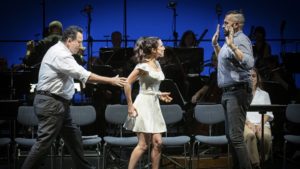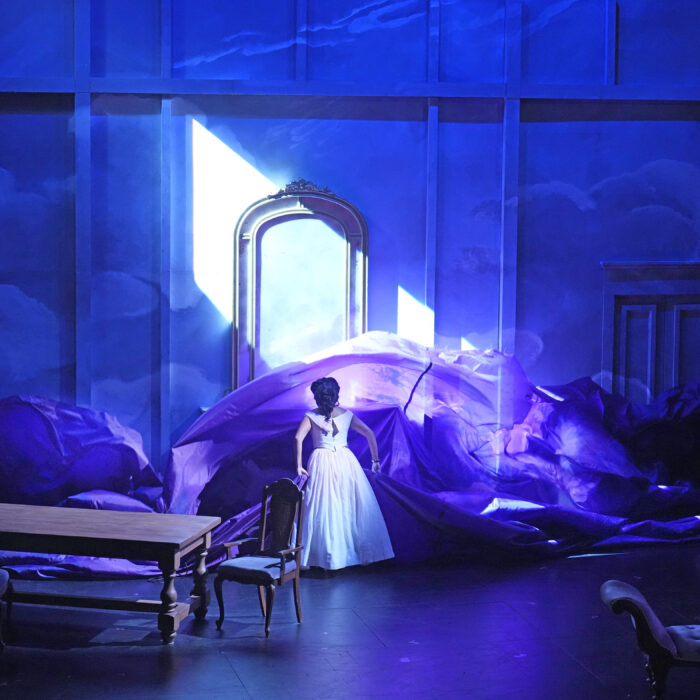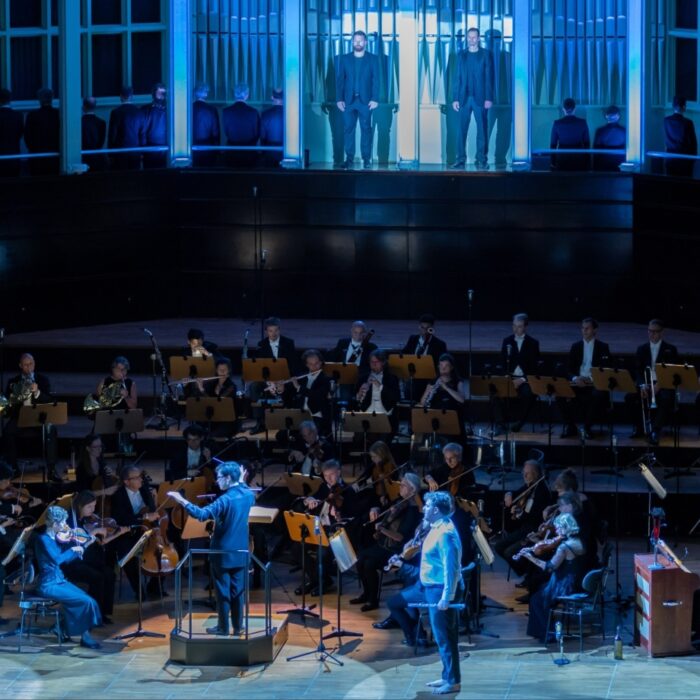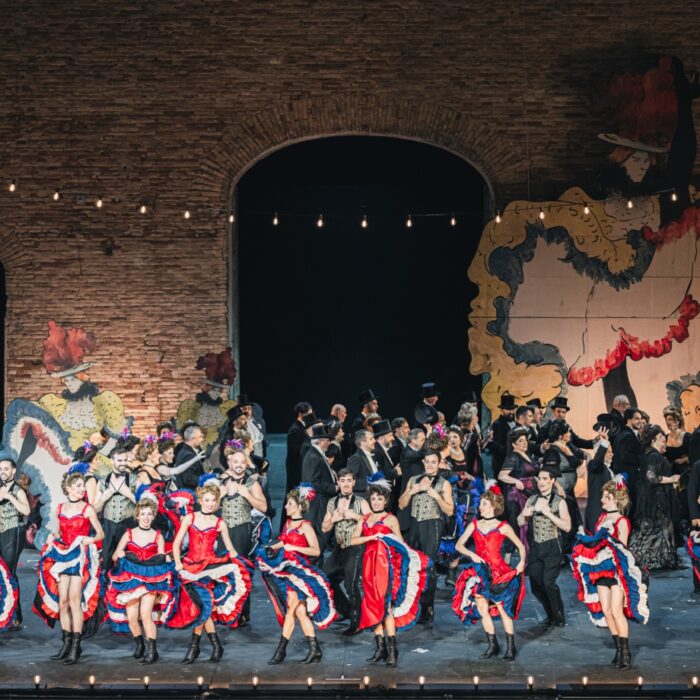
Innsbruck Early Music Festival 2020 Review: Leonora
A Compelling Case Is Made For Bringing Ferdinando Paër’s Opera Out From Beethoven’s Shadow
By Alan Neilson(Photo: Brigitte Duftner)
Italian composer Ferdinando Paër (1771 – 1839) is significant in the history of opera for his work during the first decade of the 19th century in developing opera semi-seria by integrating attributes of serious and comic opera. And although no longer well-known, his operas do receive the occasional performance.
This year, however, there were a couple of performances scheduled for his two act 1804 semi-seria “Leonora,” in connection with Beethoven’s 250th-anniversary celebrations; indeed, it is the very same Leonora who appears in “Fidelio,” and the opera follows the same basic story. Unfortunately, the COVID-19 pandemic put pay to the scheduled performance in Martina Franca earlier in the summer, but the production at Innsbruck’s Festival of Early Music went ahead as planned.
A Unique Experience
Walking into the auditorium of Innsbruck’s Landestheater it was somewhat disappointing to see the stage set up for a concert performance: seats, music stands, and the conductor’s podium were neatly arranged with the chairs for the soloists positioned in a line along the front. In truth, it was to be expected as theater’s struggle to find ways of continuing, while abiding by the rules to contain the COVID pandemic. The fact that Innsbruck’s Festival of Early Music is going ahead at all is a blessing in itself.
Moreover, the initial disappointment proved to be totally unfounded. The director, Mariame Clément, responsible for cobbling together a presentation did an excellent job, turning a difficult situation into a success by creating what proved to be an imaginative production without scenery; it was essentially a staging in everything but name.
The front of the stage became a rehearsal space, in which the singers sometimes sat and watched the others perform or occasionally left the stage until they were needed. Usually, the singers would remain in character as they watched, grimacing or smiling at what they were seeing, occasionally they would watch as a colleague. A singer returning to the stage maybe passed a score so that they could quickly catch up, maybe it was necessary for them to put on pair of glasses in order to read it. There were bottles of water under the chairs. The cast was dressed in everyday casual clothes.
Yet, in fact, nothing was as freely managed as it appeared. The choreography was carefully controlled so that every casual movement or off-hand glance was directed towards creating a context which enhanced the dramatic impact and highlighting the pivotal moments. The clothes had obviously been carefully chosen to allow the audience to immediately identify certain characters as a type, but without compromising the casual look; Leonora was dressed in unisex trousers, a white shirt, and boots, so that by tying her hair into a bun she could quickly change appearance from female to male; Giachino, who is pursuing Marcellina, was given a macho appearance and so on.
Scenes were acted out in front of the singers’ seats, in a manner typical of a normal staged performance. However, the line between singer and character was allowed to shift and overlap, so that for the finale to each act, the characters largely disappeared and the singers re-emerged, standing behind music stands and reading from their scores as they sang.
Given that “Leonora” is a semi-seria, there were plenty of amusing interludes, mainly within the first act, revolving around Giachino and Marcellina, who were portrayed as two starry-eyed young adults, involved in a love triangle with Fedele, who is really Leonora in disguise. It was all cleverly done, without props, without scenery. The second act was, by contrast, largely serious and presented in a way that really brought out the cruelty and viciousness, the pain and terror involved, using only a wall of chairs as a suggestion for Florestano’s cell.
Such a description probably does not give a full impression of the nuance and subtlety with which the interplay between the actual drama and the rehearsal, the singers, and the characters were played out, but it all worked splendidly well.
It is hard to imagine how a fully-staged performance could have improved upon it.
A Musical Feast
Musically, Paër is credited with forming a link between the composers of the late 18th century and early 19thcentury Rossini, and listening to “Leonora” it is easy to understand why; the influence of Mozart is clearly audible, notably in the overture, and the influence of 18th century Italianate melody is much in evidence, yet at the same time it is also possible to clearly detect musical patterns which Rossini was to use and develop so successfully.
Alessandro De Marchi, conducting the Innsbrucker Festwochenorchester, delivered a fine performance, creating an expressive reading, full of rhythmic vitality, in which the interplay between the individual parts and the full orchestra was pleasingly crafted. The textural qualities of the score were carefully brought to the fore, although the woodwind sounded a little muted, possibly owing to their position towards the back of the stage. An even balance between the orchestra and singers was maintained throughout the evening.
The assembled cast was excellent across the board. The title role was essayed by soprano Eleonora Bellocci, who produced a compelling acting and singing performance, in which she captured the pain of her situation, engaged readily with the comedic moments, displayed courage in defending Florestano and reacted humanely to Marcellina’s misdirected love. Her voice is a versatile instrument which she employed with precision, allowing her to produce striking coloratura displays as she moved up and down the scale with ease. The upper register is secure, top notes are sung brightly and clearly rung with confidence. However, Bellocci is also attentive to characterization and emotional verisimilitude so that her singing is also very expressive, the vocal line carefully crafted, enveloped with her changing passions. In her Act one cavatina, “I tuoi gemiti dolenti,” followed by the aria, “Fiero aquilon furente,” she sings of her determination to rescue her husband, which she presented with force and passion, founded upon her vocal control, in which she asserted her tenacity through an exciting vocal display of coloratura, ornamentations, and trills while accenting the vocal line to reflect the textual nuance. In ensemble pieces, her voice is clearly audible, projected with strength and clarity.
Two years ago the soprano Marie Lys won the Cesti competition here in Innsbruck, impressing the judges with her wonderfully fresh, youthful voice, sparkling coloratura, and fine vocal control. She returned for this year’s festival in the largely comedic role of Marcellina, in which she not only reaffirmed her prodigious singing talent, but also showed herself to be an excellent actress as the confused youngster in love with Fedele (Leonora). Her singing once again delighted, displaying considerable versatility, nuanced phrasing, subtle ornamentations, and her engaging, brightly rendered coloratura.
The two sopranos have similar voices, but with enough difference to ensure contrast, as was seen in their duet, “Volentieri o mio carino” in which Marcellina presses Leonora to return her love, while Leonora tries to forestall her and so spare her feelings. The two voices combined beautifully, with their differing emotions clearly present in their voices. Lys’ fresh youthful pressing, parried gently by Bellocci’s more mature and slightly softer-edged timbre. In the finale to Act two they engaged in a vocal sparring match, coloratura versus coloratura, in a hi-energy vocal joust. Wonderful stuff!
The tenor Paolo Fanale played Florestano. He possesses a powerful voice, which he did little to temper, and occasionally submerged the other singers in ensemble numbers. In what was an intense presentation, Fanale engaged fully with the character, bringing out the pain he experienced following two years of imprisonment. He is introduced in the first scene of Act two with an aria, “Dolce oggetto del mio amore” surrounded by two passages of accompanied recitative. It is a demanding scene in which he reflects on his suffering, his love for Leonora, and his desire for justice. Fanale endowed his singing with a compelling intensity in which his suffering was to the fore, there was no attempt to soften the pain, he was someone living through hell. Overall, it was a confident presentation, full of emotion although occasionally lacking in nuance.
Marcellina’s father, the jailer Rocco was played by bass Renato Girolami, in what was a compelling, expressively honest presentation of a quick-tempered father with a good heart. He possesses an attractive, well-supported bass, which he used with skill to develop characterization; phrasing was carefully crafted, brimming with accented and dynamic nuance. Vocal exchanges were full of emotional import, both in parlando exchanges and set pieces, such as the fine duet with Leonora, “E traccia d’esistenza.”
Giachino, who spends most of the opera ineffectively trying to persuade Marcellina to love him, was played by bass Luigi De Donato. He created a sympathetic if somewhat hopeless character, who wins out in the end due to circumstances. Physically and vocally, however, he produced a full-blooded picture, a macho presence at odds with his wimpish character. He possesses a voice with an attractive timbre and his phrasing was cleanly molded.
Carlo Allemano captured the brutality of Don Pizarro. His dark-hued, well-supported tenor perfectly suiting the pernicious character, in what was an expressive reading. His singing was clear, strong, and articulate, coated with a malicious tint, although he softened his characterization slightly when he realized that the game was up, resignedly accepting his fate.
Kresimir Spicer arrived on cue for the ‘rehearsal’ of the final scene and dispatched the role of Don Fernando with the casual air that comes with someone used to authority, his strongly supported tenor employed maybe a little too loudly.
Together the cast supported each other well and the ensemble pieces proved to be some of the highlights of the performance. The Act two, scene three quartet, “Fermate, io lo difendo” for Leonora, Don Pizarro, Rocco, and Florestano stood out for its emotional intensity, each singer submerged within the vortex, in a quickly changing scene in which Leonora finally reveals herself as a woman. The finales to both acts also captured the attention if only for their sheer musical immediacy and powerful presentation.
The production was an undoubted success, something even the virus could not detract from, if anything it forced Clément into taking imaginative and bold steps which brought out the best from the work. At the end of the performance the bravos rang out, and De Marchi obliged by encoring the finale septet, “Ma se un poco non si pena,” much to the delight of the audience.
Fortunately, a recording of the production is planned so it will be possible to listen to it all over again.



